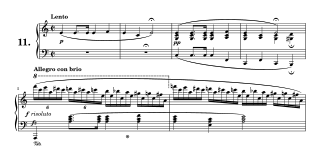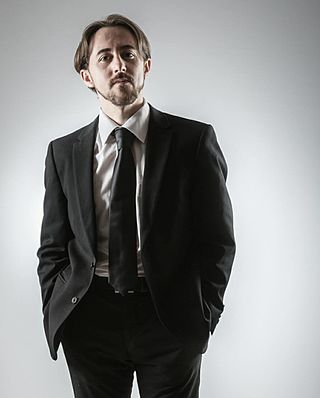
Sonata, in music, literally means a piece played as opposed to a cantata, a piece sung. The term evolved through the history of music, designating a variety of forms until the Classical era, when it took on increasing importance. Sonata is a vague term, with varying meanings depending on the context and time period. By the early 19th century, it came to represent a principle of composing large-scale works. It was applied to most instrumental genres and regarded—alongside the fugue—as one of two fundamental methods of organizing, interpreting and analyzing concert music. Though the musical style of sonatas has changed since the Classical era, most 20th- and 21st-century sonatas still maintain the same structure.

A nocturne is a musical composition that is inspired by, or evocative of, the night.

An étude or study is an instrumental musical composition, usually short, designed to provide practice material for perfecting a particular musical skill. The tradition of writing études emerged in the early 19th century with the rapidly growing popularity of the piano. Of the vast number of études from that era some are still used as teaching material, and a few, by major composers such as Frédéric Chopin, Franz Liszt and Claude Debussy, achieved a place in today's concert repertory. Études written in the 20th century include those related to traditional ones and those that require wholly unorthodox technique.

Toccata is a virtuoso piece of music typically for a keyboard or plucked string instrument featuring fast-moving, lightly fingered or otherwise virtuosic passages or sections, with or without imitative or fugal interludes, generally emphasizing the dexterity of the performer's fingers. Less frequently, the name is applied to works for multiple instruments.

Marc-André Hamelin, OC, OQ, is a Canadian virtuoso pianist and composer. Hamelin has received 11 Grammy Award nominations. He is on the faculty of the New England Conservatory of Music.

Charles-Valentin Alkan was a French composer and virtuoso pianist. At the height of his fame in the 1830s and 1840s he was, alongside his friends and colleagues Frédéric Chopin and Franz Liszt, among the leading pianists in Paris, a city in which he spent virtually his entire life.

Karl Klindworth was a German composer, virtuoso pianist, conductor, violinist and music publisher. He was one of Franz Liszt's pupils and later one of his closest disciples and friends, being also on friendly terms with composer Richard Wagner, of whom he was an admirer. He was highly praised by fellow musicians, including Wagner himself and Edward Dannreuther. Among his pupils were Hans von Bülow, Georgy Catoire, and Ethelbert Nevin.

Karl Tausig was a Polish virtuoso pianist, arranger and composer. He is generally regarded as Franz Liszt's most esteemed pupil, and one of the greatest pianists of all time.

Murray David Perahia is an American pianist and conductor. He is widely considered one of the greatest living pianists. He was the first North American pianist to win the Leeds International Piano Competition, in 1972. Known as a leading interpreter of Bach, Handel, Scarlatti, Mozart, Beethoven, and Schumann, among other composers, Perahia has won numerous awards, including three Grammy Awards from a total of 18 nominations, and 9 Gramophone Awards in addition to its first and only "Piano Award".

Kaikhosru Shapurji Sorabji was an English composer, music critic, pianist and writer whose music, written over a period of seventy years, ranges from sets of miniatures to works lasting several hours. One of the most prolific 20th-century composers, he is best known for his piano pieces, notably nocturnes such as Gulistān and Villa Tasca, and large-scale, technically intricate compositions, which include seven symphonies for piano solo, four toccatas, Sequentia cyclica and 100 Transcendental Studies. He felt alienated from English society by reason of his homosexuality and mixed ancestry, and had a lifelong tendency to seclusion.
John Andrew Howard Ogdon was an English pianist and composer.

Jonathan Powell is a British pianist and self-taught composer.
Concerto for Solo Piano is a 3-movement solo piano piece written by Charles-Valentin Alkan. The pieces are part of a 12 piece cycle entitled Douze études dans tous les tons mineurs, published in 1857. With sections marked "Tutti", "Solo" and "Piano", the piece requires the soloist to present the voices of both the orchestra and the soloist. The pianist Jack Gibbons comments: "The style and form of the music take on a monumental quality—rich, thickly set textures and harmonies ... conjure up the sound world of a whole orchestra and tax the performer, both physically and mentally, to the limit."
Jonathan "Yonty" Solomon was a South African pianist. He played with many of the world's best-known orchestras.

David Ezra Okonşar is a Turkish–Belgian pianist, composer, conductor, writer and educator. He was previously known as "Mehmet Okonşar".
Carlo Grante is an Italian classical pianist. He graduated at the National Academy of St Cecilia in Rome with Sergio Perticaroli. Later he also studied with Ivan Davis, Rudolf Firkušný, and Alisa Kezheradze. He is known as a performer of mainstream classical composers such as Franz Liszt, Wolfgang Amadeus Mozart, and Domenico Scarlatti, as well as highly demanding late romantic and 20th-century composers such as Leopold Godowsky, Ferruccio Busoni, George Flynn, Roman Vlad, Michael Finnissy, Alistair Hinton, and Kaikhosru Shapurji Sorabji. His discography consists of more than 50 albums.
A piano symphony is a piece for solo piano in one or more movements. It is a symphonic genre by virtue of imitating orchestral tone colour, texture, and symphonic development.
Alistair Richard Hinton is a Scottish composer and musicologist with a focus on the works of his friend Kaikhosru Shapurji Sorabji. He is the curator of the Sorabji Archive.

Vincenzo Maltempo is an Italian pianist. He was born in Benevento, Italy.












